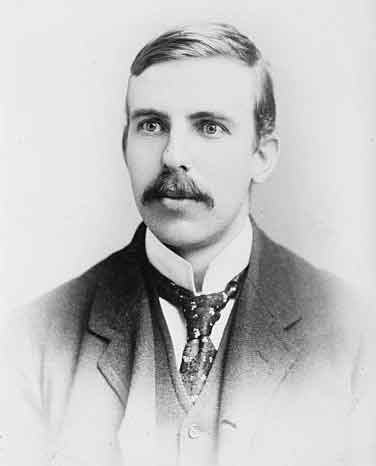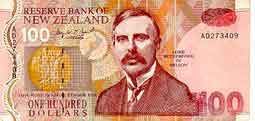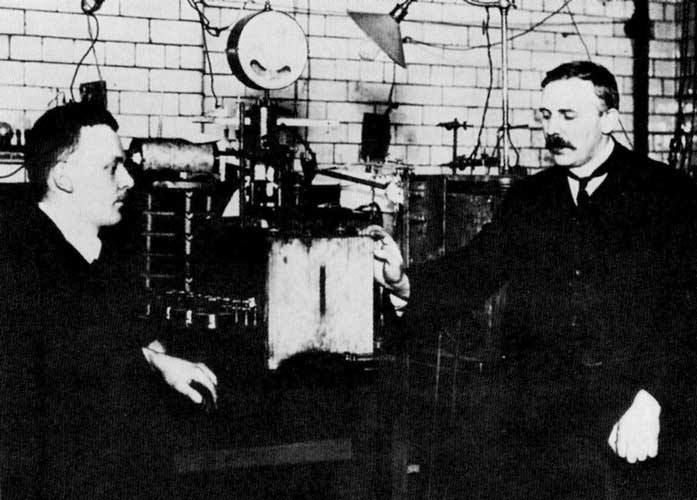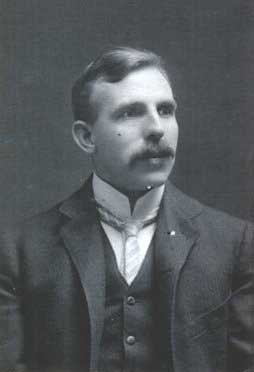.
Ernest Rutherford

Ernest Rutherford ,3 December 1908, Bain News Service
Ernest Rutherford, 1st Baron Rutherford of Nelson, PC, OM, FRS (August 30, 1871October 19, 1937), was a New Zealand nuclear physicist. He was known as the "father" of nuclear physics, pioneered the orbital theory of the atom, notably in his discovery of rutherford scattering off the nucleus with his gold foil experiment.
Rutherford was born at Spring Grove, (now in Brightwater), near Nelson. He studied at Nelson College and won a scholarship to study at Canterbury College, University of New Zealand, with three degrees and two years of research at the forefront of electrical technology.
In 1895 Rutherford travelled to England for postgraduate study at the Cavendish Laboratory, University of Cambridge (1895-1898), and was resident at Trinity College. There he briefly held the world record for the distance over which wireless waves were detected. During the investigation of radioactivity he coined the terms alpha, beta, and gamma rays.

Lord Rutherford of Nelson on the New Zealand 100 dollar note
In 1898 Rutherford was appointed to the chair of physics at McGill University where he did the work which gained him the 1908 Nobel Prize in Chemistry. He had demonstrated that radioactivity was the spontaneous disintegration of atoms. This is ironic given his famous remark "In science there is only physics; all the rest is stamp collecting.". He noticed that in a sample of radioactive material it invariably took the same amount of time for half the sample to decay — its "half-life" — and created a practical application for this phenomenon using this constant rate of decay as a clock, which could then be used to help determine the actual age of the Earth that turned out to be much older than most scientists at the time believed.
Rutherford's coat of arms, which incorporates Hermes Trismegistus (left) and elements from his native New Zealand, a kiwi bird (top) and a Maori warrior (right). The Latin motto Primordia Quaerere Rerum means "To seek the first principles of things", taken from On the Nature of Things by Lucretius.
In 1907 he took the chair of physics at the University of Manchester. There he discovered the nuclear nature of atoms and was the world's first successful "alchemist": he converted nitrogen into oxygen. While working with Niels Bohr (who figured out that electrons moved in specific orbits) Rutherford theorized about the existence of neutrons, which could somehow compensate for the repulsive effect of the positive charges of protons by causing an attractive nuclear force and thus keeping the nuclei from breaking apart.
In 1917 he returned to the Cavendish as Director. Under him, Nobel Prizes were awarded to Chadwick for discovering the neutron (in 1932), Cockcroft and Walton for splitting the atom using a particle accelerator and Appleton for demonstrating the existence of the ionosphere.
His research, along with that of his protege, Sir Mark Oliphant was instrumental in the convening of the Manhattan Project.
He was knighted in 1914, was admitted to the Order of Merit in 1925 and in 1931 was created Baron Rutherford of Nelson of Cambridge in the County of Cambridge, a title which became extinct upon his death. He appears on New Zealand's $100 note and has appeared on postage stamps of the Soviet Union (1971), Canada (1971), Sweden (1968) and New Zealand (1971 and 1999). In 1997 the element rutherfordium was named in his honour. Also craters on Mars and the Moon are named after him. An asteroid was named for his birth place.
President of the Royal Society 1925 - 1930
Preceded by: Sir Charles Sherrington
Succeeded by: Sir Frederick Hopkins

Hans Geiger with Erner Rutherford in Manchester
Links

Ernest Rutherford
Retrieved from "http://en.wikipedia.org/"
All text is available under the terms of the GNU Free Documentation License

